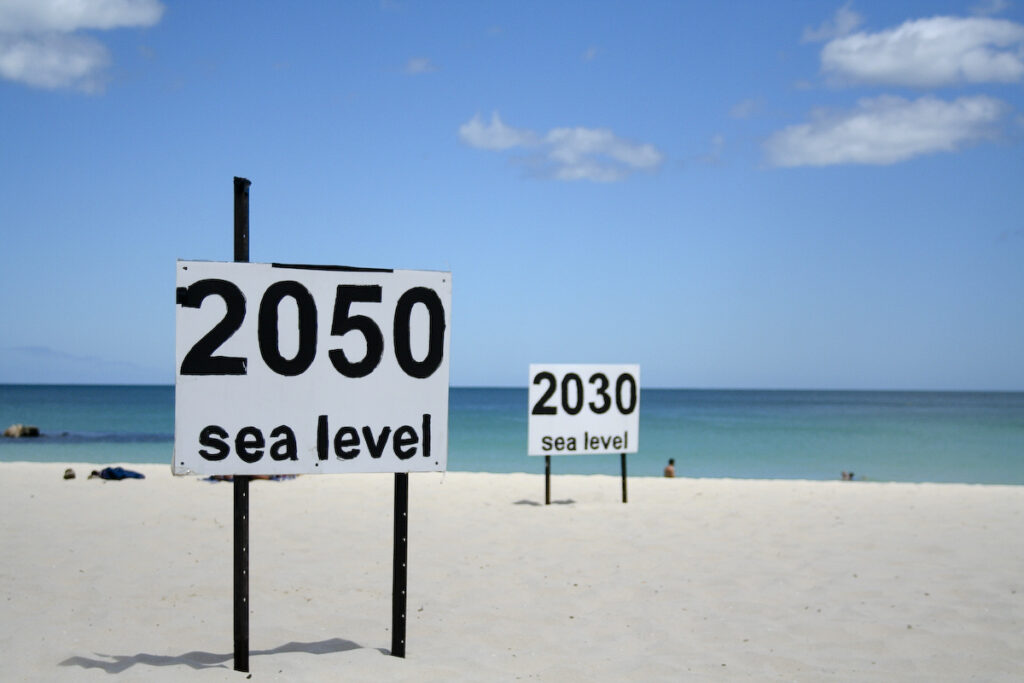
Source: go_greener_oz/flcikr
Surfing communities around the world are facing significant threats from climate change. As global temperature rises and weather patterns become more unpredictable, the very essence of surfing is at risk.
This article will explore how climate change will negatively impact surfing by 2050, highlighting the key challenges and potential consequences for surfers and coastal communities.
What is Climate Change and How It Will Affect Surfing in the Future
Climate change is the long-term alteration of Earth’s climate patterns, including shifts in temperature, weather events, and precipitation, primarily driven by human activities such as burning fuels, deforestation, and pollution from industrial processes. These activities emit greenhouse gases into the atmosphere, trapping heat and causing the planet’s average temperature to rise—an effect commonly called global warming.
The ongoing changes in Earth’s natural climate patterns can have several adverse effects on the ocean, ultimately impacting surfing for the next 25 years in the following ways:
Rising Sea Levels
The rising sea levels are one of the fastest and most visible impacts of climate change on surfing. As global temperatures rise, polar ice caps melt, causing ocean waters to expand. This phenomenon threatens coastal communities and surf breaks worldwide.
According to the National Oceanic and Atmospheric Administration (NOAA), sea levels will rise around 12 to 13 inches by 2050. This means many famous surf spots could be submerged or altered beyond recognition by 2050. Coastal erosion and changing ocean dynamics can lead to the loss of essential sandbars and reefs that create ideal surf conditions. The rising sea levels will likely drown low-tide surf spots like Stockton Avenue, Pitas Point, and Sandspit, California.
Read more: Coastal Erosion and their Impacts on Surf Spots and Surfing Communities.
Changing Wave Patterns
Climate change alters ocean currents and wave patterns, making it harder for surfers to predict when and where the best waves will roll in. Researchers have observed shifts in wave heights, directions, and frequency due to changing climate dynamics.
Due to these changes, the number of rideable waves at some popular surf destinations in the following decades may decrease. Unpredictable weather patterns, frequent storms, and rising sea levels will contribute to this challenging scenario.
Increasing Storm Intensity
Climate change is also intensifying tropical storms and hurricanes. These extreme weather events significantly threaten coastal communities and can result in dangerous surf conditions. As storms grow more powerful, they produce larger and more chaotic waves, which can be extremely hazardous for surfers. Surfers will likely face increased risks, so staying updated on weather forecasts and exercising caution when heading out to catch waves during stormy periods is imperative.
Pollution and Water Quality
Climate change can exacerbate pollution and negatively affect water quality in surf zones. Warmer ocean temperatures can promote harmful algal blooms and create favorable conditions for bacteria like Vibrio, which can cause illnesses in surfers.
Moreover, the increased frequency of extreme weather events, such as heavy rainfall and flooding, can wash pollutants from urban areas into the ocean. This can lead to beach closures and health risks for surfers.
Loss of Biodiversity
Surfing is about riding waves and immersing oneself in the rich marine ecosystems that thrive along the coasts. Climate change threatens these ecosystems through ocean acidification, coral bleaching, and habitat destruction. As these ecosystems decline, surfers may lose the chance to witness the diverse marine life often present during surfing adventures.
What Can We Do? Promoting Eco Surfing
While the negative impacts of climate change on surfing are concerning, surfers and coastal communities have the power to take proactive steps to mitigate these effects and promote eco-friendly surfing practices. Here are some actions that can make a difference:
1. Reduce Carbon Footprint: Surfers can reduce their carbon footprint by choosing eco-friendly transportation options, such as carpooling or using electric vehicles to reach surf spots. Additionally, supporting sustainable surfboard manufacturing processes and investing in boards made from recycled or sustainable materials can help lower the sport’s environmental impact.
2. Support Coastal Conservation: Get involved in local coastal conservation efforts. Participate in beach cleanups, support organizations dedicated to preserving coastal ecosystems, and participate in initiatives protecting shorelines and natural habitats. By actively contributing to coastal conservation, surfers can help maintain the health of their beloved surf spots.
3. Embrace Sustainable Surfing Gear: Use eco-friendly surf gear and apparel. Many companies are now producing wetsuits and surf accessories made from sustainable materials. Supporting these products encourages the industry to adopt more sustainable practices.
4. Responsible Travel and Tourism: Be mindful of your environmental impact when traveling to surf destinations. Choose accommodations that prioritize sustainability and responsible tourism. Respect local regulations and cultures, and support businesses committed to protecting the environment.
5. Educate and Advocate: Surfers can play a big part in raising awareness about climate change and its impact on their sport. Engage in conversations with fellow surfers, friends, and communities to educate them about the importance of climate action. Advocate for policies that reduce carbon emissions, and coastal pollution and protect coastal areas.
6. Support Research and Initiatives: Support scientific research on climate change and its impact on the oceans. Back initiatives and organizations that work to mitigate climate change and protect coastal environments. By contributing to research and efforts to combat climate change, surfers can actively participate in preserving their favorite surf destinations.